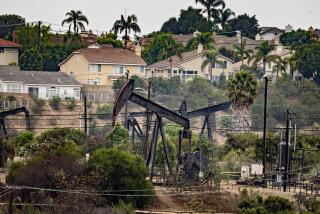Culver City challenges new oil drilling
In a legal battle that pits old industrial uses against urbanization, Culver City is challenging an environmental impact report approved by Los Angeles County that could allow 600 new wells to be drilled in a local oil field over the next 20 years.
A week ago, Los Angeles County Superior Court Judge James Chalfant upheld Culver City’s 6-month-old moratorium on new drilling in the northern section of the 85-year-old Inglewood Oil Field, which is within city limits. City officials said the moratorium was needed to provide time for development of new drilling regulations aimed at addressing health issues.
Chalfant had been expected on Monday to rule on a separate lawsuit filed by the city asking that he scrap the county report related to plans to drill new wells, in part because none of the 1,000-acre field’s existing 1,463 active, idle and abandoned wells has undergone such a review.
Instead, a hearing on the matter was pushed back to June 3 to give parties more time to negotiate a settlement. If the county report is invalidated, a new one will be required before new drilling can occur.
Plains Exploration and Production Co. of Houston has filed applications to drill at least three new wells in the field, which lies primarily in the unincorporated Baldwin Hills area southwest of downtown Los Angeles.
Attorneys for the company have argued that it has a right to drill new wells in what remains a working oil field. Culver City, however, contends that the company does not have an absolute right to drill in an area where the population has mushroomed dramatically since oil drilling began.
“The age of the oil field does not give an oil company the right to avoid mitigation necessary to protect residents,” said Garrett Hanken, an attorney representing Culver City.
Resident Leslie Ekker recalled an incident in 2006 when Plains Exploration’s drilling operations vented noxious fumes that swept across nearby neighborhoods.
“It was quite strong and we were more than a little worried by smells of sulfur dioxide and crude oil,” said Ekker, a special effects supervisor who moved into the area nine years ago. “I feel it is very irresponsible for Plains Exploration to operate an oil field according to health and safety standards that date back nearly a century.
“This company has a moral obligation to protect the community that has grown up around its field,” he added.
Jeffrey Dintzer, an attorney representing Plains Exploration, agreed, up to a point.
He said the company has installed safeguards designed to prevent similar incidents in what he described as “one of the most heavily regulated oil fields in the state.” For example, he said, a portable flare has been stationed on site to burn off volatile fumes.
Beyond that, he said, “until we convert to alternative energy sources, it is to the advantage of all of us to use natural resources on home soil.”
The field also generates more than $50 million a year in royalties for some of Los Angeles’ oldest families, he said.
As for complaints from neighbors, he said, “People who live in surrounding communities knew the oil field was there when they decided to move in.”
Oil drilling operations have been conducted in the sprawling expanse of oil and gas wells, tank farms, pipelines and conduits since 1924 -- long before the development of nearby homes. Today, however, the field is surrounded by more than a million people living within five miles. It also abuts a Culver City park used by youth soccer and baseball teams.
Now, in a display of growing opposition to continued drilling in an increasingly urban area, Culver City’s lawsuit has been joined by environmental and community groups, including the Natural Resources Defense Council, Concerned Citizens of South Los Angeles, the Citizens Coalition for a Safe Community and Community Health Councils Inc.
With only a few new wells drilled since 1985, many residents had come to believe that the oil field was tapped out and winding down operations, said Damon Nagami, an attorney representing the Natural Resources Defense Council.
“As a result, with the help of state parks authorities, we came up with a new vision for the area in 2002 that included development of a magnificent 2-square-mile park,” he said.
The same year, however, Plains Exploration began securing drilling rights.
More to Read
Sign up for Essential California
The most important California stories and recommendations in your inbox every morning.
You may occasionally receive promotional content from the Los Angeles Times.











